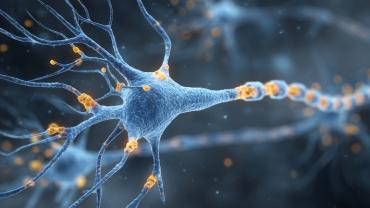
While cortisol and melatonin are most commonly associated with circadian rhythms, neuropeptides are pivotal in sleep physiology and cortisol regulation. Orexin (also called hypocretin) is an excitatory neuropeptide localized in the hypothalamic region of the brain. Humans possess approximately 10,000 to 20,000 orexinergic neurons that release two peptides, orexin-A and orexin-B, which then act on two receptors (OX1R and OX2R). These receptors are distributed across arousal, autonomic, and limbic circuits and help regulate stress-related neurobiological responses. Orexin also influences memory and cognition indirectly through its impact on sleep. While best known for stabilizing wakefulness and processing circadian input, orexinergic neurons also receive input signals related to motivation and visceral cues. As a result, orexin helps integrate signals related to energy balance, mood, stress, and sleep regulation.
Mechanisms of Orexins, HPA Physiology, and Circadian Timing
An internalized circadian rhythm, which lasts approximately 24 hours, is mainly regulated by the suprachiasmatic nucleus (SCN) and functions as a master clock by syncing cortisol release with environmental light-dark cycles. Healthy cortisol modulation typically follows this circadian cycle, with peak levels occurring in the morning and gradually declining throughout the evening. When circadian timing is disrupted, such as through shift work or irregular schedules, both baseline and reactive cortisol patterns can become dysregulated, weakening stress resilience.
The HPA axis governs this cortisol stress response. Corticotropin-releasing hormone (CRH) neurons in the hypothalamus stimulate the pituitary to release adrenocorticotropic hormone (ACTH), which then triggers cortisol secretion from the adrenal cortex. Orexin neurons activate CRH-producing cells in the paraventricular nucleus (PVN) at the central level, enhancing hypothalamic-pituitary signaling and increasing cortisol output.
Cortisol release helps maintain homeostasis and provides negative feedback on both the hypothalamus and the pituitary. In a healthy state, orexin supports appropriate ACTH and cortisol responsiveness, contributing to normal stress resilience. With repeated stress, this neural network may result in sustained HPA tone. Chronic activation can lead to maladaptive hyperarousal and sustained alertness.
Sleep dynamics also depend on arousal-promoting systems, including monoaminergic, cholinergic, histaminergic, and orexinergic neurons, which help maintain wakefulness and facilitate the shift between non-REM and REM sleep.
Orexin neurons are most active during wakefulness and mostly inactive during sleep, helping maintain sleep continuity and prevent fragmentation. Balanced orexin signaling supports smoother transitions between sleep stages and healthy REM regulation. In contrast, stress-related activation of the HPA axis can disrupt orexin signaling, leading to disrupted sleep, altered REM latency, reduced slow-wave sleep, and impaired ability to maintain consolidated rest.
Persistent sleep loss can further impair this system and act as a physiological stressor, contributing to cognitive, metabolic, and psychological disturbances. It is also important to note that sex-related differences have been documented, with females displaying greater orexin-mediated HPA activation than males, contributing to a higher susceptibility towards stress-related sleep disturbances.
Clinical Implications and Future Directions: Orexin Signaling
Dysregulated orexin-HPA-sleep interactions play a role in the pathophysiology of many conditions, ranging from stress-related psychiatric disorders like anxiety and insomnia, to metabolic disorders, and neurodegenerative disease. When orexin signaling becomes dysregulated, the body may experience a chronic state of hyperarousal, which drives persistent cortisol release, disrupts sleep architecture, and limits the body’s ability to recover and repair. On the other hand, too little orexin activity, as seen in neurodegenerative disorders, is linked to fatigue, reduced alertness, and a blunted stress response.
Behavioral and lifestyle strategies form the foundation for recalibrating this system. Encouraging consistent sleep-wake patterns, morning light exposure, and intentional evening wind-down routines may help restore circadian alignment and balance orexin activity. Interventions such as cognitive behavioral therapy for insomnia (CBT-I), structured daylight therapy, and mindfulness-based stress reduction promote healthy sleep quality and physiological stress recovery.
Movement and nutrition are also critical levers in supporting orexin function. Regular physical activity, especially early in the day, may regulate orexin neuron activity and improve daytime alertness. Similarly, balanced nutrient timing and consistent meal patterns may promote metabolic stability, reducing late-night surges in orexin that may interfere with sleep. Pairing circadian-focused behavioral strategies with targeted nutrition support creates a strong foundation for a healthy circadian rhythm and resilience.
In clinical practice, integrating orexin-related insights into a broader systems approach can deepen understanding of a patient’s sleep and stress physiology. Tools such as diurnal salivary cortisol mapping, actigraphy for circadian assessment, and sleep tracking devices provide context for personalized interventions. Layering these insights with clinical data, like heart rate variability, nutrient patterns, and inflammatory factors, may help practitioners identify focus areas where lifestyle, nutrition, and environment may disrupt circadian and stress balance.
Conclusion
Ultimately, orexin represents more than a single neuropeptide and is part of a broader communication network linking the brain, adrenal system, and circadian rhythm. Supporting this system through consistent routines, nourishing food, restorative sleep, and stress regulation can profoundly impact both mental and physical health, allowing patients to sleep better and promote a healthy neuroendocrine balance.
To learn more about sleep and stress response:
Don’t Sleep on These Tips: Re-Set Your Sleep Routine
Magnesium and Healthy Sleep Patterns
Managing Stress May Be a Key to Blood Glucose Control
By Rachel B. Johnson, MS, CNS, LDN